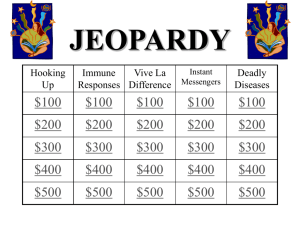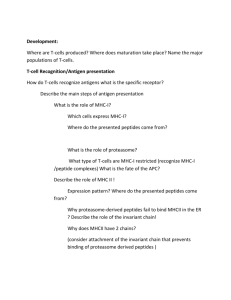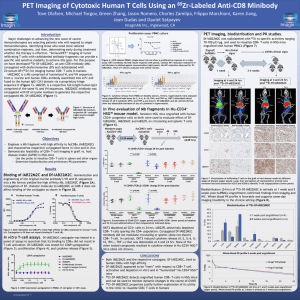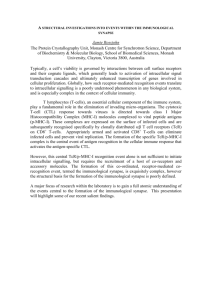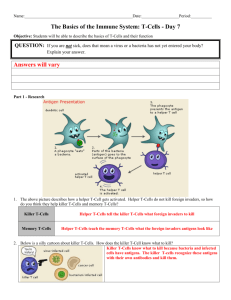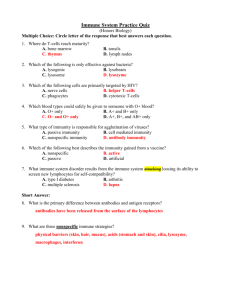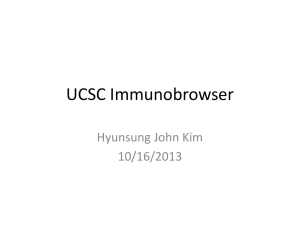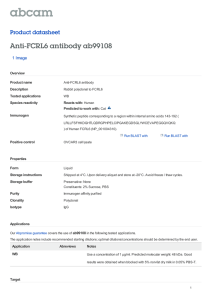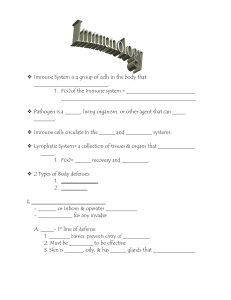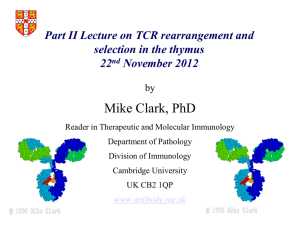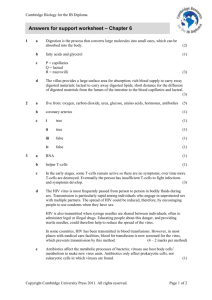Chapter 18 Questions:
advertisement
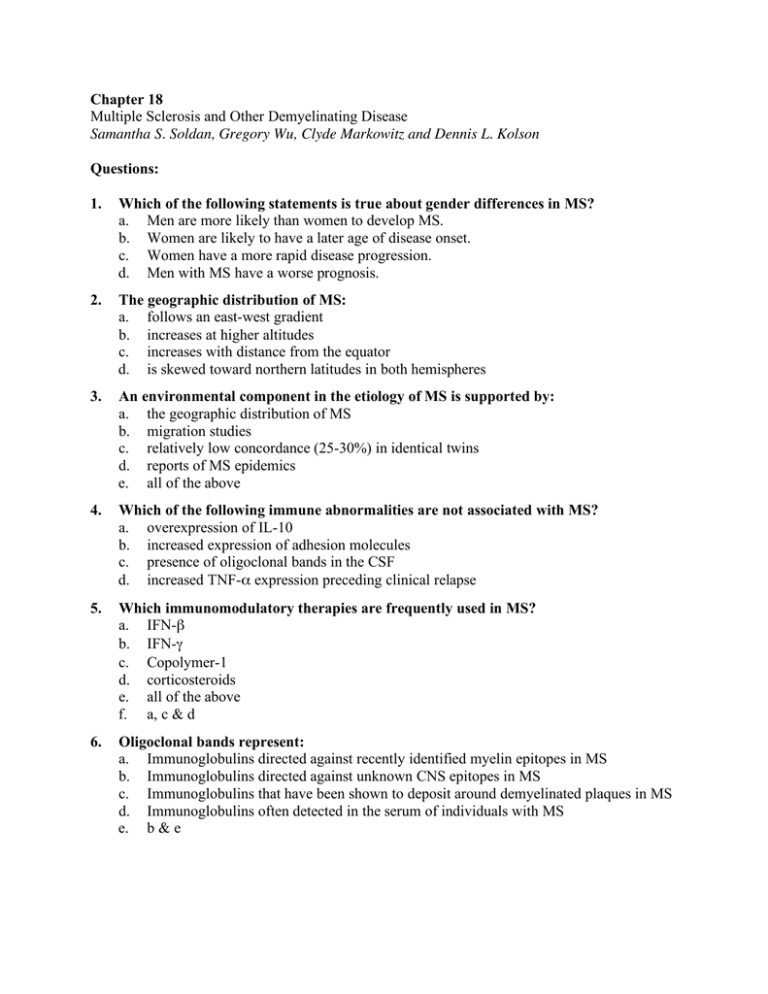
Chapter 18 Multiple Sclerosis and Other Demyelinating Disease Samantha S. Soldan, Gregory Wu, Clyde Markowitz and Dennis L. Kolson Questions: 1. Which of the following statements is true about gender differences in MS? a. Men are more likely than women to develop MS. b. Women are likely to have a later age of disease onset. c. Women have a more rapid disease progression. d. Men with MS have a worse prognosis. 2. The geographic distribution of MS: a. follows an east-west gradient b. increases at higher altitudes c. increases with distance from the equator d. is skewed toward northern latitudes in both hemispheres 3. An environmental component in the etiology of MS is supported by: a. the geographic distribution of MS b. migration studies c. relatively low concordance (25-30%) in identical twins d. reports of MS epidemics e. all of the above 4. Which of the following immune abnormalities are not associated with MS? a. overexpression of IL-10 b. increased expression of adhesion molecules c. presence of oligoclonal bands in the CSF d. increased TNF-α expression preceding clinical relapse 5. Which immunomodulatory therapies are frequently used in MS? a. IFN-β b. IFN-γ c. Copolymer-1 d. corticosteroids e. all of the above f. a, c & d 6. Oligoclonal bands represent: a. Immunoglobulins directed against recently identified myelin epitopes in MS b. Immunoglobulins directed against unknown CNS epitopes in MS c. Immunoglobulins that have been shown to deposit around demyelinated plaques in MS d. Immunoglobulins often detected in the serum of individuals with MS e. b & e 18. Multiple Sclerosis and Other Demyelinating Disease Samantha S. Soldan, Gregory Wu, Clyde Markowitz and Dennis L. Kolson 2 7. MS plaques have been histologically demonstrated to include: a. infiltration of CD8+ T-cells b. infiltration of CD4+ T-cells c. infiltration of B-cells d. IgG deposition e. Complement deposition f. all of the above g. a & b h. a,b & c i. a, b, c & d 8. Which of the following statements is false? a. In MS plaques perivenular infiltrates contain mainly mononuclear and lymphocytic cells, including CD8+ T-cells, CD4+ T-cells, macrophages, and B-cells. b. In the EAE model, the primary infiltrating cell is the CD8+ T-cell. c. Effective MS treatments generally target T-cell responses d. In both EAE and MS, disease susceptibility is influenced by genes that control presentation of antigens to T-cells. 9. In the pathogenesis of MS, molecular mimicry implies: a. Receptors mediating T-cell migration have overlapping function, i.e., they can mimic each other’s ligand specificity. b. Immune modulating chemokines or cytokines can mimic the molecular functions of each other. c. Structural similarity of foreign antigens and myelin protein components may lead to cross-recognition by myelin-reactive T-cells. d. Suppression of selected T-cell responses can have a global impact on both CD4+ and CD8+ T-cells. 10. Comparison of EAE with MS shows the following: a. Both demonstrate monophasic, relapsing, and chronic progressive clinical courses b. Perivascular inflammation is common in both. c. Demyelination is diffuse throughout the brain in both. d. All of the above e. a & b 11. Which viruses have been associated with an increased risk for development of MS? a. Herpes simplex (HSV) b. Human herpes virus-6 (HHV-6) c. Measles d. Varicella-zoster e. Rubeola f. Epstein Barr g. All of the above h. a, b, c & f 18. Multiple Sclerosis and Other Demyelinating Disease Samantha S. Soldan, Gregory Wu, Clyde Markowitz and Dennis L. Kolson 3 12. Among the viruses listed in question 11, which ones have been demonstrated to be causative agents in MS? a. a b. b c. c d. d e. e f. f g. All of the above h. None of the above 13. Which features of Theiler’s virus-induced CNS disease make it a useful model for MS? a. The animals develop chronic and/or relapsing paralytic symptoms. b. Both diseases are under multigenic control by immune response genes. c. Both are predominantly TH-1 mediated disorders. d. B-cell infiltration predominates in Theiler’s virus induced disease. e. a & b f. a, b & c g. a, b, c & d 14. Apoptosis of which cell type is a histological hallmark of at least one pathologic subtype of MS plaque? a. neuron b. astrocyte c. oligodendrocyte d. macrophage e. none of the above 15. Optic neuritis is the presenting symptom in what percentage of MS patients? a. 10% b. 20% c. 30% d. 40% e. 50% 16. The diagnostic criteria for MS: a. Depend upon the demonstration of white matter abnormalities in the brain or spinal cord by MRI. b. Require evidence for the presence of neurological dysfunction for the diagnosis in all cases. c. Require that there is no better explanation (other than MS) for the clinical presentation. d. None of the above e. a, b & c f. a & c g. b & c 18. Multiple Sclerosis and Other Demyelinating Disease Samantha S. Soldan, Gregory Wu, Clyde Markowitz and Dennis L. Kolson Answers: 1. d 2. c 3. e 4. a 5. f 6. b 7. f 8. b 9. c 10. e 11. g 12. h 13. g 14. c 15. b 16. g 4
